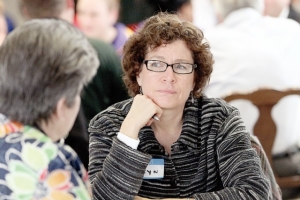What will it take to improve health?
By Phyllis Moore
Published in News on January 19, 2012 1:46 PM

News-Argus/MICHAEL BETTS
Eryn McAuliffe, director of Wayne County Services On Aging, listens as Dr. Ellen Brubeck, physician at O'Berry Center, shares suggestions on how to create a healthier Wayne County. The session, held at Lane Tree Golf Club and Conference Center, was the first of four planned for the coming months to develop the Wayne County Community Health Assessment.

News-Argus/MICHAEL BETTS
Ken Jones, area director for Eastpointe, places a Post-It on a flip chart during a brainstorming session about what will make Wayne County a healthier community.
Imagine a healthy Wayne County.
What would that look like?
Fifty representatives from around the county turned out Wednesday morning at Lane Tree Golf and Conference Center to brainstorm answers to that question.
Hosted by Wayne Memorial Hospital and Wayne County Health Department, they were divided into groups to develop ideas for the Wayne County Community Health Assessment. Specifically, they targeted such areas as families and neighborhoods, as well as churches, schools and supplemental agencies that serve residents.
"It's like putting a magnifying glass over the county," explained Carolyn King, health education supervisor with the Health Department. "This is a process that's been going on a very long time. The Health Department has been participating in community health assessments as far back as the early '80s, so this is not new to them."
Rebecca Craig, chief financial officer at Wayne Memorial, said a new regulation from the IRS requires the hospital to submit a community needs assessment every three years to retain its tax-exempt status.
Those gathered -- including representatives from health care, education, county and city offices, churches and law enforcement -- were invited to help in the assessment over the coming year, addressing concerns and working to develop action plans.
Three additional meetings are planned, in March, May and August. A team of student nurses from East Carolina University's Center for Survey Research will also lead focus groups and conduct phone surveys and gather data from state and local sources to be used in the final report.
"In this day and time, we really don't know where health care is going, but we sure do need to know what our targets are and we need to work together," said Bill Broadaway, chairman of the hospital board of directors.
Mrs. Craig shared statistics about the county to illustrate the growing need.
She said that over the past decade, the population in Wayne County has risen from 113,000 to 123,000. During 2010, the top causes of death locally were cancer and heart disease. Poverty is also a pervasive problem, as are obesity and diabetes, she said.
Just as glaring, she pointed out, is a message from the surgeon general that the country could be faced with the first generation where the parents outlive their children -- all because of declining health habits.
So, she suggested to the 50 people in the audience, what are some ways Wayne County could become a healthier community?
Evelyn Coley, interim health director, shared her group's answers -- which ranged from the need for higher-paying jobs and more opportunities for physical activities at work to a fitness trail at Herman Park, affordable local produce and midwives at the hospital.
"Educate the workforce on healthy foods," she added, pointing out a similar need at church suppers and civic events.
"No fried chicken," she suggested, which drew laughs from the crowd.
Allison Pridgen, director of student support services for Wayne County Public Schools, was spokesperson for her table.
"We believe family is where all this begins," she said. And while the "typical" family has changed, there is still a need for family-geared activities and efforts.
Churches are notable agents for change, Mrs. Pridgen said, and would benefit from education and lay nurses. School nurses at every school is another imperative, she said. And with the rising number of cases of diabetes, especially among youths, the community will need more than one endocrinologist.
As for neighborhoods, she said her group discussed the need for safer environments and opportunities to get outdoors and engage in physical activities.
One group mentioned the importance of parents taking time to play with their children, said its spokesman, John Richards, executive director of the YMCA.
"The family does not do that like they used to," he said, adding another need mentioned was to "do a better job teaching children the health consequences later in life for not eating healthy."
Rovonda Bradford, from March of Dimes, suggested physicians offering free clinics or other options for those unable to afford health care, introducing more intramural sports teams and churches partnering with community agencies to provide transportation for those in need.
At the table where Dr. David Tayloe, of Goldsboro Pediatrics, was spokesman, there were Latinos, prompting discussion on lack of insurance as well as language barriers in that population.
He also cited the growing need for adults to have what he called a "medical home."
Oftentimes, he explained, parents get health care for children but, depending on their needs, might see up to four different doctors during the year.
At the next meeting, planned for March 21, the group is expected to react to the initial findings.
